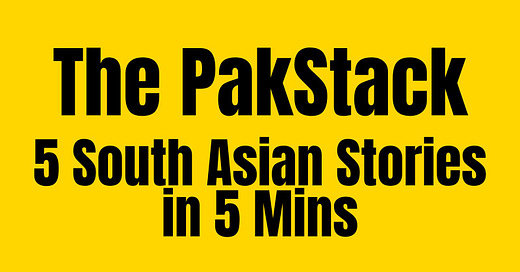The PakStack — July 7
Munir torches Delhi’s ‘China feed’ myth; PML-N humors fading Zardari; France slams Beijing’s Rafale smear—Munir brands Delhi “paindoo.”
Welcome to The PakStack, where what matters today in Pakistan, India and the rest of South Asia can be read and processed in five minutes or less.
Written by Shiza M. / Edited by Wajahat S. Khan
Ghost Boots, Hammer Blows & Bull Runs
Munir to Delhi: “No Chinese Boots Here”
Responding to India Army Deputy Chief of Staff’s allegations that India was fighting Pakistan + China + Turkey, Field Marshal Munir has shredded Delhi claims in his sharpest critique to date about India’s foreign and military policy
Branding India’s claim that PLA officers piped “live inputs” into Pakistan’s war room during May’s missile clash as “irresponsible and factually incorrect,” dismissing it as cover for Delhi’s strategic blindness and arguing that its vaunted “strategic autonomy” has shrunk into parochial self-alignment—an outdated stance in today’s fluid, multi-bloc world.
Rewrites the scorecard. He says India’s Operation Sindoor fizzled because of poor planning, not Chinese sorcery, while Pakistan’s counter-strike (Bunyan-ul-Marsoos) proved its “indigenous capability and institutional resilience.”
Lays down red lines: Citing an ISPR statement, Munir warns that any strike on Pakistan’s population centers, military bases, economic hubs, or ports will “instantly invoke a deeply hurting and more-than-reciprocal response,” underscoring that he escalation ladder is still intact and Islamabad is prepared to climb it fast
Grabs the moral high ground: Casting Pakistan as a “regional stabilizer,” he paints India’s “hegemonic Hindutva” as the real spoiler and urges outside powers to ignore Delhi’s “camp-politics” plea for anti-China and anti-Turkish solidarity.
Keeps the fight bilateral. By flatly denying any Chinese co-belligerence, Islamabad blocks Delhi from internationalizing the conflict and keeps Washington’s cease-fire phone line plugged into the two sub-continental capitals.
Takeaway: Munir’s back from America with a bang. His legitimacy compounded over lunch with Trump, his broadside against does more than vaporize Delhi’s “PLA-whisperer” conspiracy—it drags the fight back to its raw, bilateral core w. His promise of a “deeply hurting, more-than-reciprocal response” turns every Indian target map into a hall of mirrors: a hit on Karachi’s docks or Lahore’s suburbs could boomerang into Mumbai’s skyline or an IAF strip in Rajasthan. By dubbing India’s foreign policy as “hegemonic Hindutva,” he recasts Islamabad from usual suspect to “regional stabilizer”. For the record, I’m still 50-50 on whether Beijing quietly passed a few coordinates—probability, not proof—but the claim’s strategic value is now gone. Even critics who loathe Rawalpindi’s iron grip concede—through gritted teeth—that the general’s mafioso-level cool when hitting back at India makes Islamabad look sharper and Pindi more fortified. In the next flare-up, Delhi must fight—or fail—on its own muscle memory while scrambling for an alibi that doesn’t summon Chinese ghosts.
Rafale Reputation Dog-fight: Beijing’s Alleged Info-Ops
French intel traces a smear campaign to Chinese embassies. A leaked assessment says defense attachés in Beijing’s missions briefed officials from at least six countries, insisting Rafales “under-performed” in May’s India-Pakistan air clash while touting Chinese fighters as superior.
Indonesia tops the target list. Jakarta’s follow-on order for 18 more Rafales was singled out; attachés pushed J-10C packages and hinted at sweeter financing via the Belt-and-Road fund.
Playbook: disinfo meets demos. The briefings were backed by viral posts, doctored cockpit footage and AI-generated infographics that painted Pakistani-flown Chinese jets as “out-scoring” Indian Rafales during Operation Sindoor/Bunyan-ul-Marsoos.
Paris cries foul, Beijing shrugs. France’s Defense Ministry calls it a “vast campaign of disinformation”; China’s MoD dismisses the charge as “groundless slander,” while state media mocks French “sales anxiety.”
Big money, bigger geopolitics. Dassault has 533 Rafales sold or on contract; any buyer churn ripples into Paris’s Indo-Pacific footprint and India’s narrative of air-superiority.
Takeaway: The Indo-Pak dog-fight didn’t just test missiles—it opened a marketing war. If the French report holds, Beijing is shifting from hard-sell to hard-spin: undercut a prestige Western platform, push Chinese metal, and peel buyers out of Paris’s orbit. The tactic is cheap, deniable, and perfectly timed—Indonesia, the Gulf, even Egypt are mulling add-on Rafales just as India parades them as its ace card. For Paris, the risk isn’t a single lost deal; it’s a narrative cascade that dents Europe’s leverage in the Indo-Pacific. Expect Dassault to counter by fast-tracking F4/F5 upgrades and flying demo teams through ASEAN capitals. For New Delhi, the episode is a reminder that hardware buys also demand perception management—Rafales must now win an information war, not just an air war. And for Islamabad, the buzz serves Chinese interests neatly: every doubt cast on the Rafale raises the stock of the J-10C and the upgraded JF-17, reinforcing the very triangle—Beijing-Islamabad-arms commerce—that Delhi fears most.
PSX Breaks 133k—Bulls Go Parabolic
Fresh record close. KSE-100 leapt 1,421 points (+1.08 %) to 133,370, after topping an intraday high of 133,862—its fourth milestone in a week.
Banks carry the charge. HBL (+3.7 %) and Bank Alfalah (+4.3 %) led 76 gainers on hopes of fat Q2 dividends; only 24 stocks fell as breadth widened.
Textiles pop on Pak-US tariff deal buzz. A provisional trade-framework with Washington lifted export names and fed the “tariff-peace” narrative ahead of the July 9 signing window.
Volumes explode. Turnover hit 920 m shares (Rs 45.3 bn), up 26 % day-on-day—evidence that retail money is chasing momentum, not hedging.
Macro tailwinds stay kind. June CPI cooled to 3.2 % YoY, the lowest in two years, while YTD the index is already up ≈22 % (66 % YoY), leaving analysts to debate whether a mid-July SBP rate cut is next.
Takeaway: The PSX’s turbo-run is no longer a bounce; it’s a regime change. Cooling inflation, a stable rupee and whispers of a Pak-US tariff truce have fused into a self-reinforcing feedback loop: cheaper money expectations boost banks, banks lift the index, and the rising tape lures sidelined cash back in. Daily volume north of Rs 45 billion suggests retail traders—burned by real-estate and crypto—are treating equities as the only liquid inflation hedge left. Yet stretched breadth hides fragilities: the rally is crowded in banks, textiles and fertilizers, while energy and insurers lag. With the KSE-100 now 22 % higher for 2025 and 66 % above last July, valuations still look cheap versus regional peers, but upside depends on two catalysts holding: (1) Washington inks the tariff framework on schedule, and (2) the SBP delivers at least a token rate cut without spooking the rupee. Miss either cue, and today’s euphoria could morph into the kind of vertical reversal Karachi knows all too well.
Hammer & Hunt: 35 Militants Down, Three Fronts “Secured”
Border gun-battle leaves 30 militants dead. Security forces in Hassan Khel, North Waziristan, spotted a large column crossing from Afghanistan and “sent all 30 Indian-sponsored khawarij to hell, “according to ISPR; a haul of rifles, IEDs and rockets was recovered
Punjab CTD foils Taunsa mega-plot. Acting on tip-offs, CTD teams raided hide-out near the Tri-Border Village, killed five fighters linked to Fitna al Hindustan and seized three primes suicide vests plus grenades—averting what officials call “a catastrophic attack”
Nasirabad IED wounds highway cops. A remote-controlled blast ripped through a patrol vehicle on Rabi stretch of the N-65, injuring three officers; investigators suspect the BLA, underscoring Balochistan’s widening insurgent toolkit
ISPR turns up the diplomatic heat. In the same statement, the army warned Kabul to stop “foreign proxies” using Afghan soil and hinted at a hot-pursuit option if more columns slip the border
Narrative war goes global. Washington Post notes July’s strike is the second mass kill at the Durand Line since April, part of a surge Islamabad pins on Indian patronage—charges New Delhi dismisses as “baseless”
Takeaway: Three theatres, one message: Pakistan is on offense. In 48 hours security forces have stacked up a 35-to-0 militant body-count versus just three police injuries, giving Islamabad its best optics since April. North Waziristan’s firefight justifies sharper pressure on Kabul—and quietly signals that a cross-border chase is no longer taboo. The Taunsa bust proves Punjab’s CTD still has the network chops to choke off attacks before they hit the metropolitan core, while the Nasirabad blast reminds everyone Balochistan’s insurgency can still bloody soft targets along critical CPEC arteries. Framing every trigger pull as “Indian-sponsored” may stretch credulity for the 50-50 crowd on Delhi’s real footprint, but the line delivers diplomatic utility: it fixes responsibility on India, cements Afghan complicity and primes foreign capitals for any future hot-pursuit across the Durand Line. If July’s tempo holds, Islamabad may keep its body-count edge—yet the deeper test will be whether this hammer-and-hunt posture can stanch the steady drip of roadside bombs before they soak into the national mood.
Return of the Khaki King: Field Marshal Munir’s Bid for Aiwan-e-Sadr
Coup talk gains traction. Regional outlets claim “multiple sources” see Field Marshal Asim Munir maneuvering to replace President Asif Ali Zardari, framing it as logical next step after his fifth-star promotion and Washington trip
Indian and regional media echo the buzz. Free Press Journal claims local sources see the army chief “likely to become new president” as Zardari’s relevance fades, stoking fears of yet another khaki reboot.
PML-N keeps PPP on a short leash. Ishaq Dar insists the PPP will “remain our ally” but isn’t angling for ministries, while Defence Minister Khawaja Asif floats the idea of the party re-entering cabinet “if the national agenda requires it” — diplomatic phrasing that also underlines the PPP’s shrinking leverage.
Zardari signs off on four new chief justices. Approving permanent heads for every provincial high court is the president’s loudest proof-of-life in months, but critics call it a last flicker before the lights go out.
Interior minister tries to kill the story. Mohsin Naqvi brands talk of Zardari’s ouster “social-media disinformation,” claiming some are “disturbed” by rare civilian-military harmony. Few are reassured.
Takeaway: Islamabad’s favorite parlor game—guess the next palace shuffle—has a new frontrunner: Field Marshal Asim Munir. The theory fits a widening pattern: extended term, fifth star, a muscular stance on India, and a high-profile U.S. tour all suggest he no longer sees GHQ as the ceiling. Still, ejecting a sitting president requires impeachment, resignation, or another constitutional tweak—none yet visible. Meanwhile the PPP’s leverage is evaporating; Dar’s “no ministries” line and Asif’s open-ended invitation translate to stay useful or step aside. Zardari’s rush to sign off on chief-justice appointments shows he can still wield the pen, but also highlights how little else remains under civilian control. Naqvi’s denial buys time, yet the fact he had to issue it shows where gravity is drifting. Whether the transition comes by velvet handshake or blunt decree, Pakistan’s political markets are already pricing Munir as president-in-waiting—leaving investors and diplomats to ask not if the khaki will move upstairs, but how soon and on what terms.






Absolutely brilliant article!!